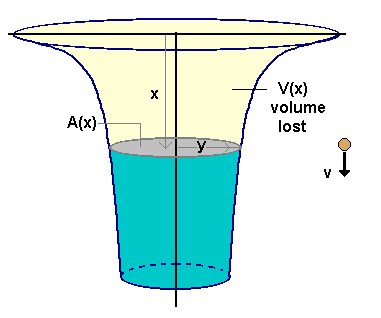| Emptying a container |
Here's an interesting problem:
Take my word for it, okay? Anyway, since dV/dt = C we have:
|  Figure 1 |
Here's the problem:
Find a container shape such that the speed of the water level (that's dx/dt) is the same as the speed of a body falling freely under the influence of gravity.
>Huh?
Sorta like this. Now, pay attention.
- A freely falling body, starting with an initial speed of vo, attains a speed v m/s after falling a distance x m, where::
v2 = vo2 + 2gx g, measured in m/s2, is the acceleration of gravity - Setting dx/dt = v (so the speed of the water level equals the speed of the falling body) gives:
A(x) = C/(dx/dt) = C / {vo2 + 2gx}1/2 - However, for our container,
A(x) = π y2 - Hence we get:
y = {C / π }1/2 / { vo2 + 2gx }1/4
>Yeah, so what does such a container look like?
Did you notice Figure 1? 